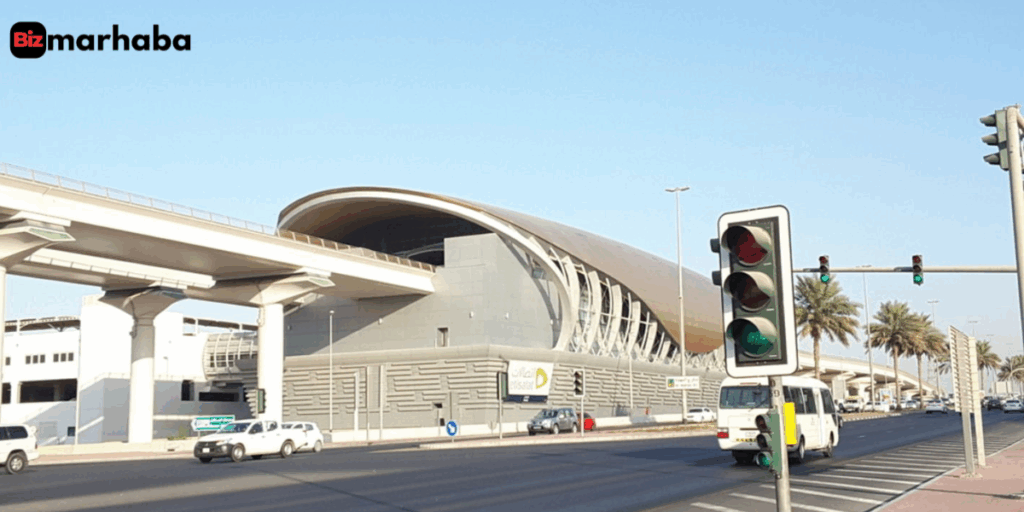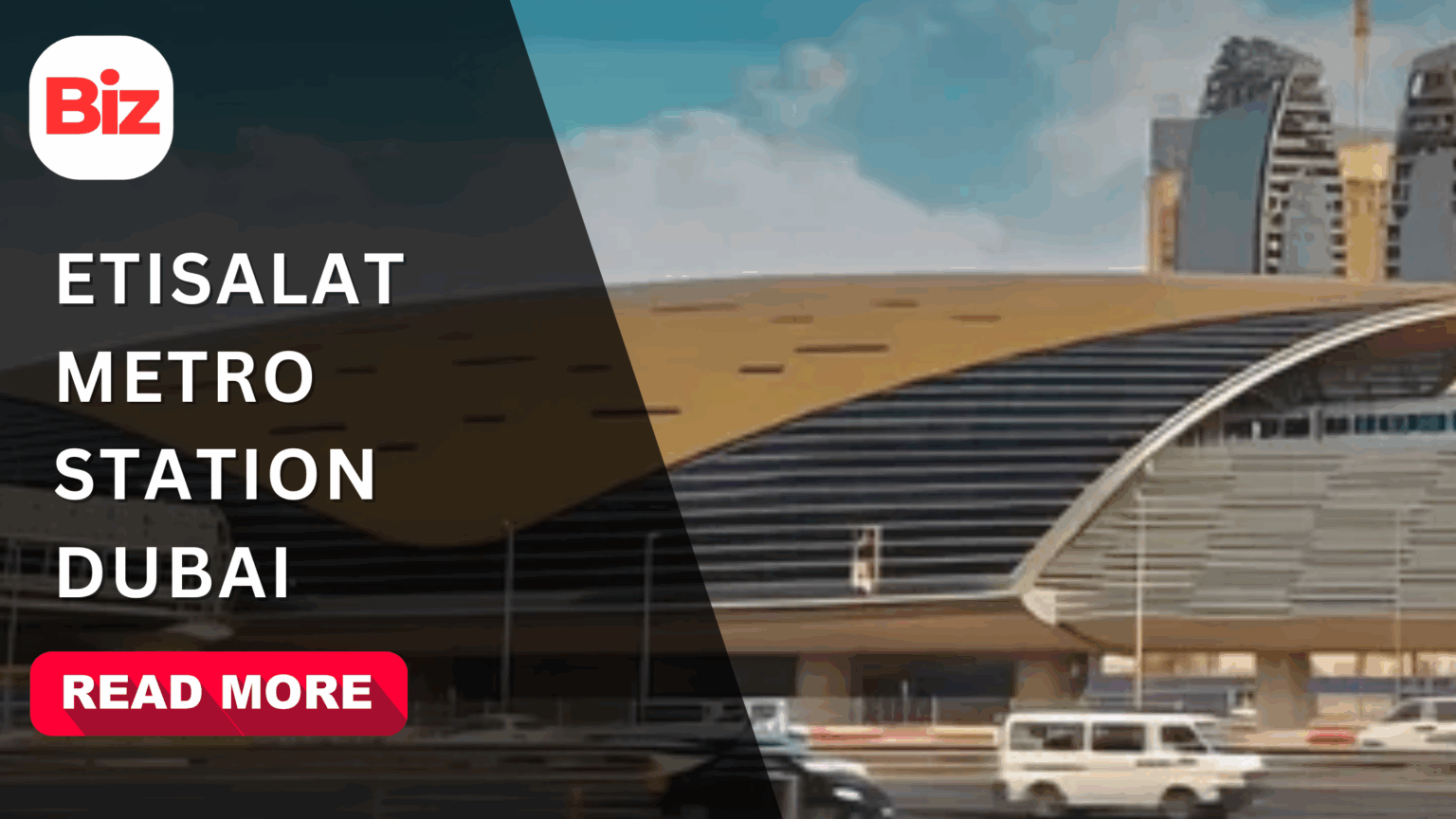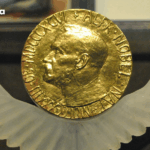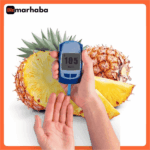- A Quick Look at the Station’s Background
- Etisalat Metro Station Location
- Etisalat Metro Station Parking
- Etisalat Metro Station Directions
- What’s Inside the Station?
- Timings and Train Frequency
- Who Uses Etisalat Metro Station?
- Why Commuters Rely on Etisalat
- Nearby Landmarks and Attractions
- Safety and Security
- Tips for First-Time Visitors
- Shaping the Way the City Moves
- Why You Should Use It
- FAQs
Each city possesses a gateway and to thousands of daily commuters traveling between Sharjah and Dubai, Etisalat Metro Station Dubai becomes this gateway. Not only is it the end of the Green Line, it is the beginning of the daily routine that propels this rapidly expanding city.
For years, drivers battled Al Ittihad Road, one of the UAE’s most notoriously congested highways. But in 2011, when the station opened, a new habit was born: leave the car in Al Qusais, step inside a sleek metro terminal, and glide past the traffic into the city. For many, it’s not just transportation, it’s relief.
Etisalat is not a tale of grandiose architecture and groundbreaking engineering. It’s about practicality. A park-and-ride fix, a commuter cutoff, a quick-and-easy offer: you do not have to spend hours in a traffic jam. And that’s why it matters.
A Quick Look at the Station’s Background
Etisalat Metro Station was first opened on September 9, 2011 in the course of the Green Line extension. It was then made the northern terminus, the last station at which the line turns back towards Dubai Creek and the busy centre.

It is located in Zone 5, and it occupies the Al Qusais neighborhood. And though it does not receive the exact same attention as the Burj Khalifa or Dubai Mall stations do, its contribution to the daily routine cannot be overestimated. To commuters of working classes, students and travelling families, Etisalat is the reliable beginning or conclusion of their travel.
Etisalat Metro Station Location
The first thing most people want to know: Where is it exactly?
The Etisalat Metro Station location is on the corner of Al Nahda Street and Al Qusais, only a few minutes off the Sharjah border. That is a strategic placement- it gets traffic running in Sharjah before it becomes a mess.
Here’s why the location matters:
- Sharjah commuters can park and board without entering central Dubai congestion.
- Al Qusais residents find it walkable or a short taxi ride away.
- Proximity to institutions like Dubai Men’s College and Al Bustan Centre Mall makes it a convenient hub for students and shoppers.
Think of it as a pressure valve. It relieves pressure on Al Ittihad Road, one of the UAE’s busiest highways, by encouraging drivers to shift from cars to metro.
Etisalat Metro Station Parking
This is the game changer. The etisalat metro station parking facility is one of the largest in Dubai’s metro system, with space for over 2,300 vehicles. That is why it has become the park-and-ride park of choice of people commuting in Sharjah.
Capacity: 2,300 and above over several levels.
Price: Free in case you carry on your ride on the metro. In case you simply put your car aside and leave without getting in, there are standard RTA parking rates.
Security: Surveillance by CCTV and Patrols and providing commuters with peace of mind.
Parking hint: Come before 8:00 am to ensure you get a place on weekdays- spots are taken quickly during the rush hour.
For commuters, this isn’t just convenience. It’s strategy. Parking here means skipping an extra hour of bumper-to-bumper traffic.
Etisalat Metro Station Directions
If you’re driving, finding the station isn’t complicated, but peak-hour traffic can make navigation tricky. Here’s a guide for those searching for etisalat metro station directions:
From Sharjah: Follow Al Ittihad Road toward Dubai. Just before entering the main congestion near Al Nahda, take the Al Nahda Street exit. Follow the signs for Etisalat Metro Station.
From Central Dubai: Head east via Al Quds Street, then turn toward Al Twar. The station is well signposted from this route too.
By Bus: Several RTA bus routes terminate here, including feeders from Muhaisnah and Al Twar.
By Taxi: Every driver knows the spot; just say “Etisalat Metro.” Drop-off zones are clearly marked.
Tip: Use the RTA Wojhati app for real-time public transport routes, including bus-to-metro transfers.
What’s Inside the Station?
On the surface, Etisalat looks like a standard Dubai Metro station. But walk inside, and you notice how it’s built with commuters in mind:
- Ticket counters and Nol card top-up kiosks to handle the morning rush.
- Retail kiosks selling snacks, water, and essentials.
- Accessibility features including ramps, elevators, tactile flooring, and dedicated seating.
- Restrooms and waiting areas that make it family-friendly.
- Wi-Fi connectivity, keeping travelers online during their wait.
Design-wise, it follows Dubai Metro’s modern aesthetic: clean lines, bilingual signage, and climate-controlled interiors. It’s not a landmark station, but it’s efficient and that’s what regulars care about.
Timings and Train Frequency
Commuters live by the clock, and Etisalat Metro Station runs on the dot:
- Opening hours: 5:00 am to midnight (extended until 1:00 am on Fridays and Saturdays).
- First train departs: Around 5:05 am.
- Last train arrives: Just before midnight.
- Peak frequency: Every 5 minutes.
- Off-peak: Every 7–10 minutes.
Reliability is its biggest selling point. For many, the certainty of a train every few minutes beats the unpredictability of traffic by far.
Who Uses Etisalat Metro Station?
Stand outside at 7:30 am and you’ll see the rhythm of the city unfold.
- Sharjah commuters park their cars, swipe their Nol cards, and rush downstairs to the platforms.
- Students from Dubai Men’s College and nearby schools lug backpacks and laptops.
- Airport staff heading to Dubai International Airport, just a short drive away make their way in uniforms.
- Local families in Al Qusais and Muhaisnah use the station as their gateway to shopping trips downtown.
The station isn’t touristy. It’s functional. It serves the backbone of Dubai’s workforce.
Why Commuters Rely on Etisalat
Here’s the truth: Dubai’s roads are getting busier, not quieter. Al Ittihad Road has long been one of the most frustrating commutes in the region. Etisalat helps break that cycle.
For the city:
- It reduces car congestion.
- It supports sustainable, public-first transport goals.
For individuals:
- It saves time.
- It reduces fuel costs.
- It cuts stress.
Ask any commuter who has made the switch and they will tell you the same thing, predictability is everything. Being able to know you are going to Union Station in 20 minutes is even better than gambling with the rush-hour traffic.
Nearby Landmarks and Attractions
While Etisalat itself is commuter-driven, the surrounding area has its share of spots worth noting:
- Al Bustan Centre Mall: A mid-sized shopping center with groceries, dining, and retail stores.
- Al Twar Park: A green space perfect for evening walks.
- Dubai Men’s College: Part of the Higher Colleges of Technology network.
- Al Qusais community: A mix of residential blocks, restaurants, and local shops.
If you’re staying nearby, the metro station doubles as both a transport hub and a neighborhood anchor.
Safety and Security
RTA takes safety seriously at all its stations, and Etisalat is no exception. You’ll notice:
- 24/7 surveillance cameras across parking and platforms.
- Security patrols in and around the building.
- Emergency call points on every platform.
- Clearly marked exits for evacuation if ever needed.
Families and solo travelers alike report feeling safe here, even late in the evening.
Tips for First-Time Visitors
If it’s your first time using Etisalat, keep these pointers in mind:
- Get a Nol card before you arrive – ticket counters get busy during rush.
- Arrive early for parking – especially if you’re coming from Sharjah on weekdays.
- Download the RTA app – it’s the best way to plan your route and check train times.
- Explore the feeder buses – you might not need to drive at all.
- Keep change or a card ready – small kiosks inside only take certain payments.
Shaping the Way the City Moves
Etisalat Metro Station Dubai may not be a sightseeing stop, but it stands for something more vital: a city adapting to its rapid growth. Dubai is sprawling, traffic is real, and public transport is the only way forward.
This station is the blueprint for how a metro hub should work: well-placed, reliable, and supported by parking that makes life easier for those willing to switch from cars to trains.
And in a city where time is money, Etisalat isn’t just useful, it’s essential.
Why You Should Use It
If you’ve ever inched your way through Al Ittihad Road, you already know what’s at stake. Time lost. Energy wasted. Days that start stressed and end the same way.
Etisalat Metro Station changes that equation. It gives commuters a way out a faster, cleaner, calmer option. And in a city as ambitious as Dubai, that makes all the difference.
FAQs
Is the station the last stop on the Green Line?
Yes, Etisalat is the northern terminus.
How big is the parking facility?
It has space for over 2,300 cars.
Is the parking free?
Yes, for metro users. Non-users must pay standard RTA parking charges.
How do I reach the station from Sharjah?
Follow Al Ittihad Road into Dubai, exit onto Al Nahda Street, and follow the signs.
What are the operating hours?
5:00 am to midnight, extended to 1:00 am on weekends.
Is it family-friendly?
Yes. The station is accessible, safe, and has restrooms, shops, and waiting areas.








